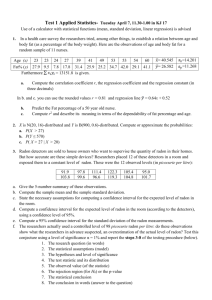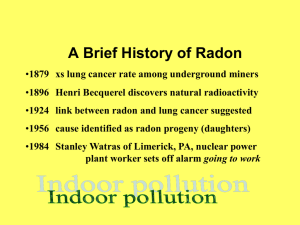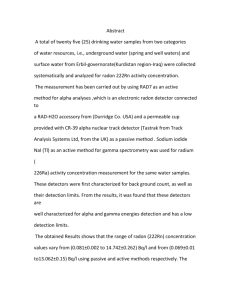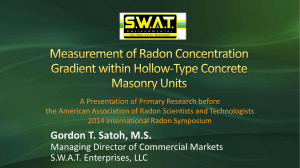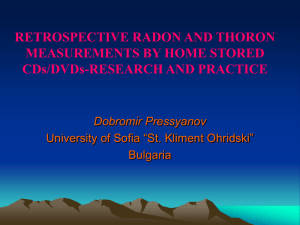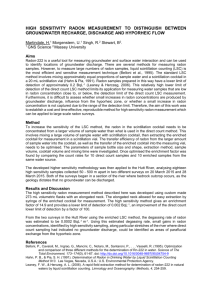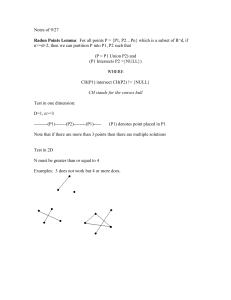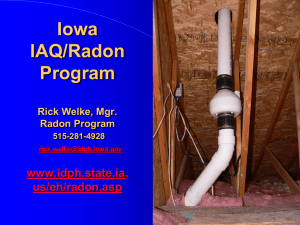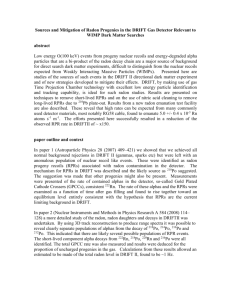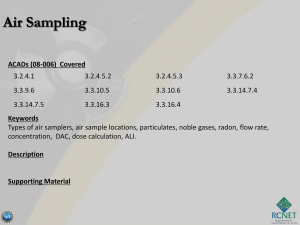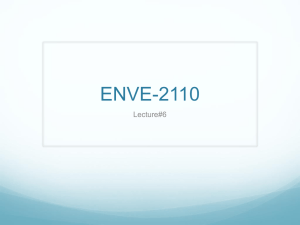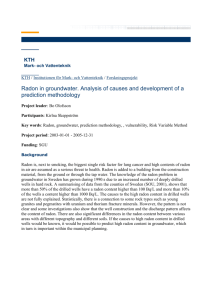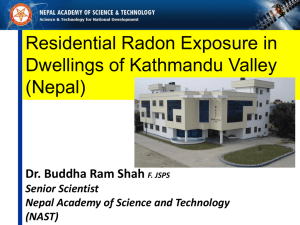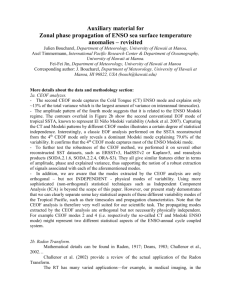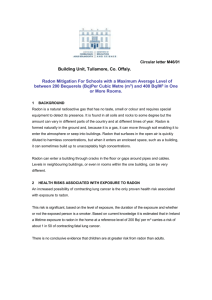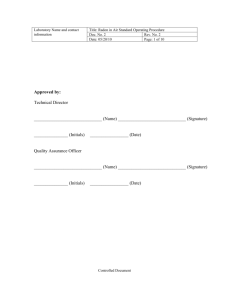Hallin LRT2010
advertisement
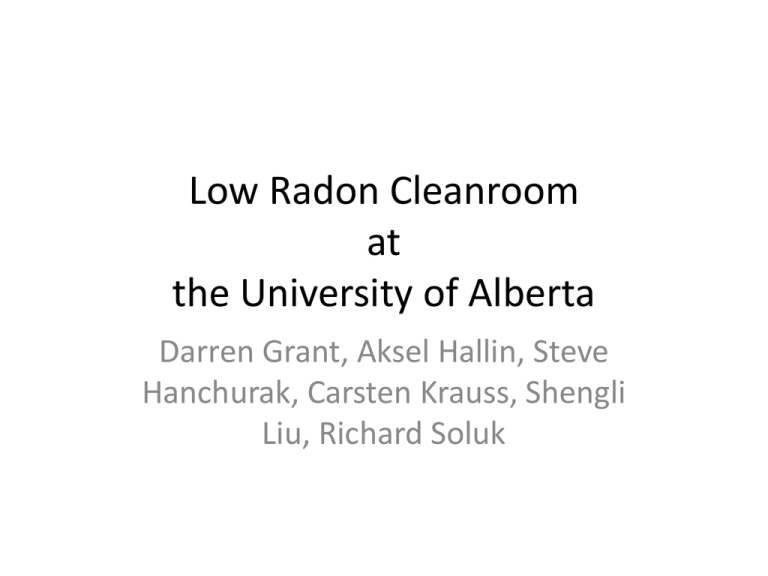
Low Radon Cleanroom at the University of Alberta Darren Grant, Aksel Hallin, Steve Hanchurak, Carsten Krauss, Shengli Liu, Richard Soluk Radon Clean Laboratory Concept Tolerable Rn load = Rn scrubber flow rate times Acceptable Rn concentration = 3 m3/min x 94 Rn/m3 = 282 Rn/min .00002 Bq/m3 9.4 222Rn/m3 3m x 10m x 10m 90 m3 room 140 m2 area 28 Rn/min 3 m3/min Lights (100 cfm) emanation 23 Rn/min If walls 10 Rn/m2hr Radon scrubber (1 cfm) Radon scrubber Electrostatic deposition plates 20 Bq/m3 9.4x106 222Rn/m3 HEPA Cooler Baffle Leaks/diffusion 23 Rn/min 30 m3/min Chemical Baths? .0002 Bq/m3 48 Rn/min 94 222Rn/m3 8460 222Rn total Class 1000 Clean Room? Lab Equipment 80 Rn/min People/ processes 80 Rn/min 2 Bq/m3 940,000 222Rn/m3 Air Lock #2 Air Lock #1 o o 9,400 222Rn in lungs 125,000 222Rn dissolved .02 Bq/m3 9,400 222Rn/m3 K. McFarlane May 16, 2006 Radon Stripping • A hybrid design will be used combining both cryogenic and pressure/vacuum swing carbon adsorption techniques • Under normal operation 3 of the tanks will be maintained at -60C and 2 of the tanks will operate at room temperature in a pressure/vacuum swing configuration • All major components and valves are automated and will be managed by process control software Radon Stripping Equipment • Atlas Copco GA30+ 30kW water cooled compressor (180CFM) • CD110 desiccant drier (-70C dewpoint) • Custom built 9kW water cooled process chiller (-65C operating temperature, 4.5kW cooling capacity) • Air to air heat exchanger for heat recovery, with a variable bypass to regulate chiller load and air temperature Radon Stripping Equipment • 5 stainless steel tanks filled with approx. 200kg each of coconut carbon • All control valves are in a custom insulated cabinet, half of which is insulated, sealed and kept at -60C the other half is at room temperature and purged with low radon processed air • Almost all non-welded connections in the piping system will be in this 3’x5’x8’ cabinet CCIS Layout • Process air will feed a sealed cleanroom in the basement of the new CCIS building (which will be completed early 2011) • A small machine shop will be installed in the cleanroom for detector fabrication • Included will be a CNC mill and lathe and both horizontal and vertical bandsaws as well as work tables and hand tools • A water purification system located outside the room will provide low radon water Cleanroom Construction • Cleanroom is a modular design using mill finish aluminum extrusions and panels produced by CleanAir Solutions • Basic wall panel consists of two sheets of aluminum sandwiching an aluminum foil honeycomb • Walls are 2” thick, ceiling panels use the same design but are ½” thick, standard panel size is 4’x10’ • Cleanroom ceiling consists of a top plenum cap 10’ high which provides the outer air seal and an 8’ suspended inner ceiling holding the lights and HEPA filters Airlock Prototype • The outer 5’x10’ airlock has been built as a prototype to test how well this cleanroom can be sealed • Doors are hollow aluminum filled with polyurethane prehung on welded aluminum frames with compression seals and additional dogs to increase clamping force between the door and frame • The floor is sealed with a 1cm thick layer of Precidium 550D a spray on polyurea industrial floor coating Airlock Prototype (2) • All Al-Al joints, such as wall panel seams are sealed on both the inner and outer surfaces using SikaLastomer 511 butyl caulking • All seams are then also covered, on both the inside and outside of the airlock with a layer of Polyken 360-17 aluminum foil backed butyl tape, this provides an additional layer of sealant and also covers the non-hardening butyl caulking Monitoring Systems • All based on electrostatic separation and solid state detection • Currently have RAD7 commercial detector, emanation chamber and tunnel detector running • Electronics records up to 24 channels of self triggered events. Time and energy are calculated and stored for each event Radon Monitor: detector head and preamp box -HV Preamplifier and shaping box: Attached to detector To DAQ board Charge Sensitive Shaping & gain 50 ohm coax. S3204 Radon Monitor: DAQ board 8X3 = 24 channel Preamp signals Anti alias FADC Digital Waveform Processing FPGA Trigger output Real time Clock 12X3 = 36 channel slow ADC Health Monitoring Micro-controller USB AD7417*3 USB PC (Labview software) Tunnel Detector Cross section: 20 cm x 20 cm Air velocity ~1.8 m/s 16.8 hours: 515 counts Po214= 31/hour 40.8 hours, 16490 counts= 400/hour Emanation Chamber Po210:2.4/hour Po218(6114 MeV)::75/hour Po214: 89/hour Po212: 9.6/hour 60 cm radius, 61 cm high Volume=0.17 m**3 Po210:1.25/hour Bi212(6051 MeV)::3.4/hour Po214: 0.3/hour Po212: 6/hour Emanation Rate N E (1 e t ) E 0.01604 332.8/0.013 24=9850 /day Calibration Conclusions? • Radon Monitoring and radon emanation systems are well advanced and working reasonably. • Radon lab is getting into shape and will be ready and useful in 2011. • There are lots of pitfalls and snares ...


